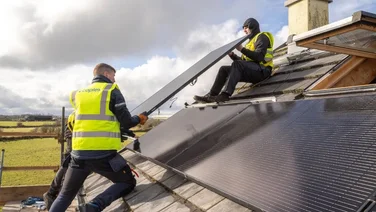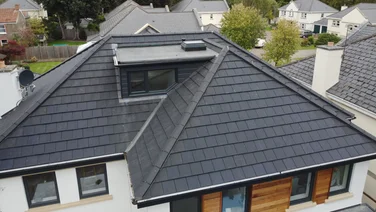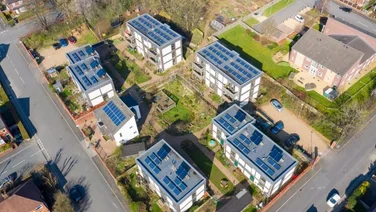- What is a solar charge controller?
- Do you definitely need a solar charge controller?
- What are the types of solar charge controller?
- What type of solar charge controller should you get?
- How much does a solar charge controller cost?
- Does a solar charge controller require any maintenance?
- Next steps
- FAQs
✔ Solar charge controllers regulate power flow between panels and batteries
✔ It’s an essential part of an off-grid solar system
✔ The type and size you need will depend on power usage and budget
Installing an off-grid solar panel system onto your property? Solar charge controllers are an essential piece of kit if you want to avoid any issues down the line, which will lead to more solar panel costs.
Not only will they bring everything together to ensure your solar system runs smoothly and safely, but they are also key to ensuring all your equipment is protected – and will last for the long term.
In this guide, we’ll explore everything you need to know to get you started with solar charge controllers. As part of this, you need to know how to protect them, so use our guide to help where cover everything from insurance to cleaning.
Considering installing solar panels on your property? Compare prices by entering a few details in this short form, and our expert installers will get back to you with bespoke quotes.
Where do you want to install solar panels?
Get started
What is a solar charge controller?
Connect a solar panel directly to a battery, and you risk severely damaging both.
This is where a solar charge controller comes in: to act as a bridge to control the amount of charge that comes from your solar panels to your battery.
Within that, a solar charge controller offers multiple protections: to stop ‘reverse polarity’ (which is when the current changes direction), to protect the battery from high surges and low voltage, as well as over-discharging (running too low) and cutting off, all of which can damage the battery.
How does a solar charge controller work?
To understand solar charge controllers, it helps to understand how solar panels work.
Each solar panel has a voltage rating, for example, 12v, which you would need to power a car battery.
However, if it’s a very sunny day, the solar panel will often generate more than its rating: a 12v for example, can generate between 16v and 20v.
So if you’re using a 12v solar panel to charge a 12v car battery, and the solar panel generates more than 12v, there is a danger of overcharging.
The controller is there to manage the amount of power that is going to the battery, when.
This is based on three stages of battery charging: bulk, absorption and float.
The ‘bulk’ stage is designed to get the battery powered up to 80%, and the current is maximised to achieve this.
The second, ‘absorption’ stage, takes the battery to being very nearly full. The voltage is kept the same, but the current will vary.
And the third, ‘float’ stage, involves having a very small but constant charge to keep the battery fully topped up.
To find out more information on batteries, visit our page: a guide to batteries for solar panels.
Do you definitely need a solar charge controller?
If you have a solar system that requires a battery, which most self-sustaining off-grid systems do, you will need a solar charge controller.
But if your solar system is attached to the national grid, then you don’t – the grid will control the flow of electricity and absorb any excess.
The other exception is very small 1- 5 watt trickle chargers – the kind you might use for an electric fence, for example – which deliver a slow charge to your battery.
Where do you want to install solar panels?
Get startedWhat are the types of solar charge controller?
Broadly, there are three kinds of solar charge controllers:
- Simple 1- or 2-stage controller: as you might expect, these control voltage in one or two stages. Though relatively basic and often considered old-fashioned, these are the cheapest option and generally very reliable.
- Pulse with modulation (PWM): these use an electric signal to ensure the right amount of power is going to the battery at each point. A PWM will also reduce voltage to a trickle when the battery is full.
- Maximum Power Point Tracking (MPPT): an incredibly precise controller, an MPPT can monitor the best voltage and amperage of the solar panel to charge the battery. This is the most efficient option.
The great improvements in PWM and MPPT models, both in terms of tech and price, mean that these now dominate the market.
What type of solar charge controller should you get?
This very much depends on your individual situation and needs.
Considerations include how much you’re prepared to spend, what your energy requirements are, the number of solar panels you’re using, and what kind of batteries you’re using (lithium-ion or lead-acid, for example), and how many.
Another factor to consider is climate: an MPPT will work better than most in cold weather, for example, but a PWM may be perfectly adequate for a sunnier climate.
What size solar charge controller do you need?
The type of solar charge controller you choose needs to be large enough to handle the amount of power being generated by your solar panels.
To work this out, add up the total watts being generated by your solar panels, and divide it by the voltage of your battery bank. The result will be the minimum amperage you need from your controller.
You can also use an online calculator.
It may be tempting to round up, but don’t – if your solar charge controller is too big it may lead to over charging.
Does a solar charge controller come with a standard solar panel installation?
Generally not, although you may be able to buy your solar charge controller from the same supplier you are buying your solar panels from. It’s worth talking to your installer about how best to approach this.
Find out more about how to choose a solar panel installer.

How much does a solar charge controller cost?
| Charge controller type | Average price |
|---|---|
PWM | £10-195 |
MPPT | £25-£645 |
As you might expect, there’s a broad range of prices for solar charge controllers. High-tech MPPTs sit at the top of the market, with more expensive models also catering for wind power and including features such as Bluetooth. PWMs are more affordable.
Prices are indicative, based on Amazon.co.uk, July 2023. Please note simple 1- and 2-stage controllers didn’t appear to be available on Amazon.
Does a solar charge controller require any maintenance?
Solar charge controllers are relatively low maintenance.
Check once a year that the controller is properly connected, and that the wires are clean and secure.
If your solar panel controller comes with an LED display you should also check the data there, and use a multimeter to test the battery power.
Next steps
If you are installing solar panels you want to use as a stand-alone power source, independent of the national grid, you will need a solar charge controller to ensure you have a safe, reliable and efficient supply.
The size and type of controller you require will depend on the number of panels you’re using, the number and type of batteries you’re using, your power needs and your budget.
You may be able to buy your solar charge controller from the same supplier who provided you with your solar panels.
If you’re thinking about installing your own set of solar panels, it’s best to compare prices before you settle on one. Thankfully, we can speed up this process. All you have to do is enter a few details in this short form, and our expert installers will get back to you with bespoke quotes.
FAQs
What does a solar charge controller do?
A solar charge controller acts as a bridge between your solar panels and your battery bank. This will ensure that the current is regulated, so that your battery won’t be overcharged or over discharged, and your battery will be protected.
Do I need a charge controller for my solar panel?
If you are installing an independent off-grid solar system that isn’t connected to the power grid, you will need a solar charge controller. The only exception to this is very small trickle chargers.
What size charge controller do I need for my solar?
To calculate the size of your charge controller, add up the total watts of your solar panel and divide it by the voltage of your battery bank. This will give you the minimum amperage required for your charge controller.





